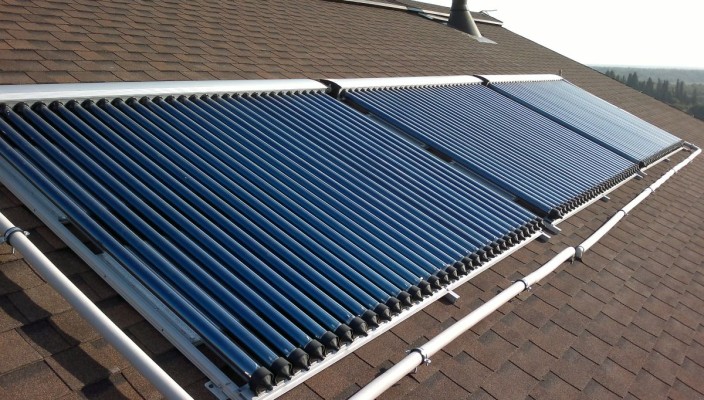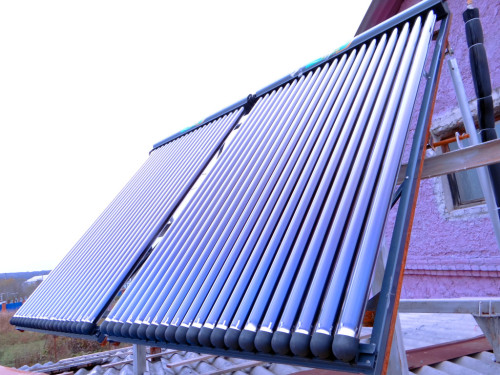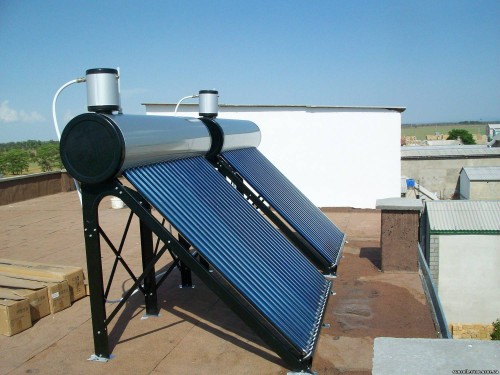In modern conditions, it is necessary to pay more attention to alternative sources of energy. Of course, so far, all this for many people may seem in incredible, but in many countries people actively use alternative sources of energy, and at the same time save huge money. It should be borne in mind that there is a sufficient number of installations on the market with which you can become energetically independent, but not all of these options show themselves from the best side.
Content
In this case, we will look at the solar collector, which allows you to provide heating and warm water a large private house. Of course, these are not empty words. In many European countries, solar collectors are successfully used for several years. The most important thing is that you need when using this collector is solar weather, which provides a dwelling with a necessary amount of energy.
But it should not think that in cloudy weather the collector immediately ceases to function. Modern models accumulate some energy, and separate installations and are able to collect energy through the cloud layer.
In this article we will try to fully analyze the possibilities and the main characteristics of modern solar collectors. We will also deal with the installation process of these settings. Using our instructions, each owner will be able to install a collector with their own hands.
Features of the solar collector
It is most important to note that the solar collector does not produce electricity as many other installations that are based on solar panels. In this case, we have the equipment that heats the coolant. Accordingly, the solar collector is suitable exclusively for the heating of the home, as well as to convert the cold water in hot.
The solar collector is equally effective in summer, and in winter. For example, in the summer, the installation provides a full heating of water, and in winter the collector can be completely translated into the heating of the home. Obviously, much depends on the capabilities of the collector. You can find various models on sale, which are provided for large and small rooms.
As for the price issue, every year solar collectors become accessible. Accordingly, this is an excellent solution that completely replaces the traditional means of heating. You can also easily abandon gas supply, and at the same time save money.
It is worth noting that you can find several types of solar collectors on sale:
- Flat collector. This is most likely the most common type of solar collectors. Such installations have special elements that have successfully absorb solar radiation. In addition, this equipment has a protective glass. The flat collector is also equipped with copper tubes, according to which the coolant spreads. This design should be completely sealed, so all holes and gaps are filled with silicone. Flat collector can heat water up to 200 degrees Celsius. This is an excellent result that is achieved in a short time. Of course, the installation efficiency increases together with an increase in the amount of incident energy (solar radiation). In this case, it is possible to increase the efficiency of the use of optical coatings.
- Vacuum collector. How can you understand from the name, the effectiveness of this collector is ensured by the created vacuum. The installation consists of pipes, inside of which even narrower pipes. Accordingly, there is a vacuum between them, due to which the large amount of energy captured is preserved. Also as heat conductor in vacuum collectors there are heat pipes. Thus, the fluid present at the bottom of the tube is heated and turns into steam. Next, the pairs rises up and transmits the heat collector. It is worth saying that such installations especially effectively show themselves at home. The bottom line is that vacuum collectors are able to submit water boiling even if the window is too low.
- Household collector. In this case, the coolant heats up, and later the thermal energy is transmitted to the tank, which performs the battery function, accumulating hot water. Often, collectors are used, which are based on a simple principle of operation. Its essence lies in circulation of water due to the temperature difference in the collector and the tank. You can also find other options for household collectors, which also have an additional electric heating element with which you can significantly increase the installation efficiency.
- Corolors-hubs. These settings have special reflectors that significantly increase system efficiency. Also used to track the sun tracking devices, the location of which depends on the position of the energy source. Of course, such installations are significantly more expensive than analogues, but for large rooms it is a good option.
- Air collectors. These are flat plants that are often used for heating small residential premises. It is worth noting that this installation is worse than the liquid coolant, and it is necessary to keep in mind. Air collectors are sometimes used for drying agricultural products. In some cases, this is a really effective option. Many owners such installations attract special simplicity of the design. Accordingly, in this case there is no need to configure. However, this advantage overlaps low efficiency.
Application of collectors
As already mentioned, most often solar collectors are used in private homes, as well as in agricultural facilities. However, often with the help of these installations, the salted sea water is cleaned. Accordingly, with the development of this industry, the process of water desalination, as well as the heating of the dwelling and heating of water, is significantly reduced.
It makes sense to use a large number of solar collectors on farms, where there is enough space for their placement. Accordingly, in this way, we get energy from almost nothing. Some agricultural associations in this way go to self-sufficiency with warm water and heating.
Advantages and disadvantages of flat and vacuum collectors
It makes sense to consider the main positive and negative aspects of the most popular solar collectors.
Among the advantages of flat collectors:
- High efficiency, which allows for warm and warm water to large living spaces. It should not be forgotten that much depends directly from the specific collector model.
- The collector can be installed at different angles, which significantly simplifies the configuration of the efficient mode of operation.
- This is the most inexpensive option from the solar collectors existing on the market. At the same time, flat plants have high reliability and durability.
As for negative parties, a flat collector has one significant drawback that lies in the loss of heat resources. This is due to the specific manifold design. With such a situation, not the highest efficiency of the installation will make itself felt in the winter period.
Positive aspects of vacuum collectors:
- High heating temperatures. Most vacuum collectors warm up heat pipes up to 300 degrees. This is a very good result, especially for the use of the installation within a private house.
- Practical design. Due to the really successful design, the vacuum collector effectively heats the heat-conducting fluid. Moreover, this fluid does not freeze in cool seasons, and this is definitely plus.
- The simplicity of installation allows the installation of a vacuum collector even a newcomer, who had not previously engaged in anything.
The negative side of the vacuum installation can be attributed to the high cost. Thus, not all will be able to purchase this collector, therefore, despite the many positive parties, many people will prefer cheaper options.
Features of installation of solar collectors
It should be borne in mind that the performance and efficiency of the solar collector is a very subtle business. The whole point is that the collection of the collector must be carried out depending on the position of the dwelling, as well as on the location of the sun.
Obviously, the most often solar collectors are installed on large private houses. Accordingly, in such conditions there may be quite many options for installing the system. It is best to pre-consult with experts who will give their assessment of the situation. Often there are two options for the location of the solar collector on the roof:
- Installation on the pitched roof. In this case, the installation of collectors takes place parallel to the surface of the roof. At the same time, you need to install the system so that it is directed to the south. This is the most effective scenario. However, small deviations can be allowed: up to 20 ° to east, as well as up to 30 ° to west. Approximately the same result must be achieved when installing on other types of roofs.
- Installation on a flat roof. Fully horizontally you can install vacuum tubular collectors, while the pipes are joined with a slight bias. As for collectors with a heat pipe, then install such systems cannot be horizontally. It is necessary to ensure at least a small slope. Of course, with the help of special racks, it is possible to ensure the optimal inclination of the collector and on the horizontal roof.
In some cases, collectors are installed on the walls of the dwelling, however, it should be borne in mind that with such a situation, access to solar radiation can be significantly limited. Therefore, such solutions still need to be previously discussed with specialists.
If the solar collector has too large area, then the installation should be carried out directly on the site. Here you also need to ensure that the solar radiation freely falls on the system.
Special attention should be paid to collector shading. Of course, such things can not be allowed, otherwise the efficiency of the installation will be rapidly falling. Sources of shade can be trees, neighboring buildings or the house itself on which the collector is installed. It is necessary to preliminarily evaluate all the threats associated with the shading, and after that it is possible to install a collector.
The rest of the installation details:
- The glazing of the collector must be shaded, and it must be carried out until the installation is filled with the coolant. Of course, without a coolant, the system will be subjected to dry overheating, which, in turn, can lead the entire collector.
- The movement of the coolant in the system should occur from the bottom up.
- In one row, no more than 3 collectors should be installed, but this is only if the compensators are installed.
Subtleties of operation:
- It should be borne in mind that the attachments of collectors must be reliable, and at the same time resistant to corrosion action. Otherwise, you will have to regularly change fasteners, as well as to produce a difficult installation of the system.
- In order to increase the efficiency of the installation during operation, all pipelines, as well as fittings, should be asleasing. This is especially important if the collector is used in the cool time of the year.
- Most collectors do not require regular maintenance. Accordingly, it significantly simplifies the use of installations within frequent houses. However, periodically still makes sense to conduct a visual inspection, which will allow to identify emerging problems.























